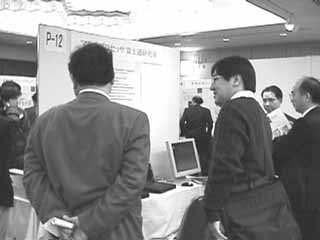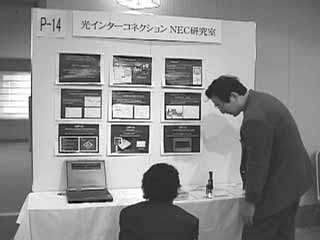Multi-Processor Computing Fujitsu Laboratory
http://www.rwcp.or.jp/activities/achievements/MP/fujitsu/index.html

On the digital poster, we present two new concepts, the processor group and the index distribution, which are introduced for applying OpenMP API to DMP environment and show the preliminary results of the performance evaluation which are obtained by the prototype compiler for the extended OpenMP Fortran API.
We also show the effects of the optimization of predicated execution which is one of the activities of studying fine grain parallelism. We have developed a compiler for a VLIW processor which partially supports predicated execution.
The reduction of branch instruction overhead, the increase of instruction level parallelism, and execution time speed-up are presented. In the best case, about a 60% speed improvement is achieved by predicated execution.
Optical Interconnection OKI Laboratory
http://www.rwcp.or.jp/activities/achievements/OI/oki/hp99-10/achieve-j.html

(1) For device-to-device optical interconnection, an optical fiber array module prototype with a high-density 125 micrometer interval manufactured using an image fiber plate and experiment data that show high efficiency and low crosstalk characteristics.
(2) For chip-to-chip optical interconnection, the basic characteristics of the one-body integrated InP-LED on an Si-LSI device produced using a heterogeneous materials connection process, an optical circuit substrate prototype produced using a deflective optical device, and optical characteristic data that show the feasibility of high-density optical wiring.
Optical Interconnection NEC Laboratory
http://www.rwcp.or.jp/activities/achievements/OI/nec/index.htm

OIP achieves a high-speed optical interconnection as an IP macro of ASIC, enabling a system design that includes optical I/O in the usual design flow by using a hardware description language. RWC 2000 digital poster will exhibit an LSI package for OIP that allows up to 6-channels I/O to be implemented with the transmission speed of 1.25Gbps/ch.
GaAsSb long-wavelength vertical-cavity surface emitting laser (VCSEL) oscillates at 1.3 micrometer in which chromatic dispersion of optical fiber becomes zero. Compared to 0.85 micrometer wavelength VCSEL which is commonly used as a transmitter of giga-bit ethernet modules, GaAsSb VCSEL has several advantages such as a wider band-width when used with single-mode-fiber and lower operation voltage. In RWC 2000, we will exhibit a first monolithically grown VCSEL chip, which achieved a room temperature CW oscillating at around 1.3 micrometer band.